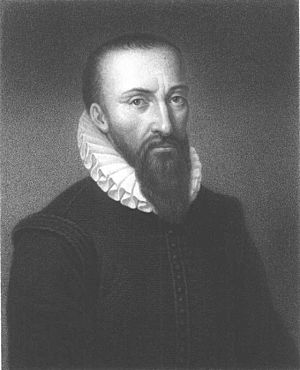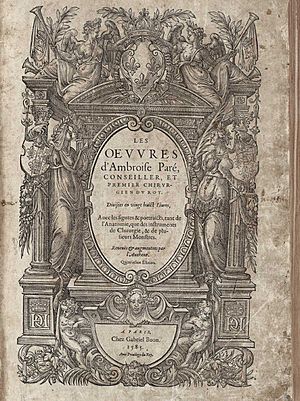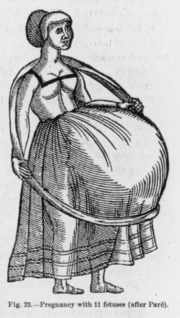Ambroise Paré facts for kids
Quick facts for kids
Ambroise Paré
|
|
|---|---|

Posthumous, fantasy portrait by William Holl
|
|
| Born | 1510 Bourg-Hersent near Laval, France
|
| Died | 20 December 1590 (aged 80) Paris, France
|
| Nationality | French |
| Citizenship | France |
| Known for | His contributions to surgery |
| Scientific career | |
| Fields | Barber Surgery |
Ambroise Paré (born around 1510 – died December 20, 1590) was a famous French barber surgeon. A barber surgeon was a person who could cut hair and also perform simple medical procedures. Paré worked for four French kings: Henry II, Francis II, Charles IX, and Henry III.
He is often called one of the "fathers of surgery." He also helped create modern forensic pathology, which uses medical knowledge to solve legal questions. Paré was a pioneer in new surgical methods, especially for treating wounds on the battlefield. He also studied the human body and invented many surgical tools.
Paré wrote in his notes: "I bandaged him and God healed him." This shows his belief that doctors help, but healing ultimately comes from a higher power. These words are even on his statue in Laval, France.
Contents
Ambroise Paré's Early Life
Paré was born in 1510 in a small town called Bourg-Hersent. This town was near Laval in northwestern France. As a child, he learned from his older brother, who was also a barber-surgeon in Paris. Paré also studied at Hôtel-Dieu, which is France's oldest hospital.
Paré's Medical Innovations
Ambroise Paré was a very careful observer. He did not let old beliefs stop him from seeing what truly worked. In his book, Journeys in Diverse Places, Paré used a method similar to today's scientific method. He did this during a battlefield experiment.
Treating Wounds: A New Method
After a battle, Paré compared two groups of injured soldiers. One group was treated in the old way, using boiling elder oil and cauterization. Cauterization means burning the wound to stop bleeding. The other group was treated with a new ointment. This ointment was made from egg yolk, rose oil, and turpentine.
Paré found that the soldiers treated with boiling oil were in terrible pain. But those treated with his ointment felt much better. The turpentine in the ointment had antiseptic properties, meaning it helped prevent infection. This showed that his new method worked much better. After this, he stopped using boiling oil to treat wounds. He published his first book about treating wounds from firearms in 1545.
Ligatures: Stopping Bleeding Safely
Paré also brought back the use of ligatures for stopping bleeding during surgery. A ligature is a thread used to tie off blood vessels. Before Paré, surgeons often used a red-hot iron to burn wounds to stop bleeding. This method was very painful and often failed, causing patients to die from blood loss or shock.
Using ligatures was a major improvement in surgery. Paré even designed a special tool called the "Bec de Corbeau" (crow's beak). This tool was an early version of modern haemostats, which are clamps used to control bleeding. Even though ligatures could sometimes spread infection, it was still a huge step forward. Paré wrote about this technique in his 1564 book, Treatise on Surgery.
Understanding Phantom Pain
While working with injured soldiers, Paré noticed something interesting. Amputees, people who had lost a limb, often felt pain in the limb that was no longer there. This is known as phantom pain. Paré believed that these pains came from the brain, not from the missing limb itself. Today, doctors agree with his idea. He also performed many brain surgeries.
Finding Hidden Bullets
In 1542, during a battle, a French general was shot in the shoulder. The bullet was very hard to find. Paré had a clever idea. He asked the general to stand in the exact position he was in when he was shot. This helped them find the bullet, and it was successfully removed.
Helping with Childbirth
Paré also made important contributions to obstetrics, the field of childbirth. He brought back a technique called podalic version. This method allowed surgeons to safely deliver a baby by turning it inside the mother. He showed that even if a baby was not in the head-first position, doctors could often still deliver it safely. Paré also influenced the education of future royal midwives, like Louise Boursier.
Paré also believed that lancing (making a small cut in) infants' gums during teething could help teeth emerge. He thought this would prevent illness. This practice was common for a long time, though it is not used today.
Serving the Kings
In 1552, Paré began working for King Henry II. Sadly, he could not save the king after a serious head injury in 1559. Paré continued to serve the French kings until his death in 1590. He worked for Henry II, Francis II, Charles IX, and Henry III.
Paré died in Paris on December 20, 1590, at about 80 years old. He was buried in the church of Saint André-des-Arts. A collection of his works, based on his experiences treating soldiers, was published in Paris in 1575. His books were reprinted many times and translated into other languages.
The Bezoar Stone Experiment
In 1567, Ambroise Paré performed an experiment to test bezoar stones. At that time, many people believed these stones could cure any poison. Paré, however, doubted this. He proved that bezoars could not cure all poisons, showing that some popular beliefs were not true.
Forensic Medicine Contributions
Paré's writings also included his careful studies on how violent deaths affect the body's internal organs. He also created a guide called Reports in Court. This guide explained how to write medical reports for legal cases. His work in this area is considered the beginning of modern forensic pathology. This field uses medical science to help solve crimes and legal questions.
Prosthetic Limbs and Eyes
Paré made important contributions to both surgical amputation and the design of prostheses. Prostheses are artificial body parts. He designed artificial limbs for soldiers who had lost them. He also invented some artificial eyes. These artificial eyes were made from materials like enameled gold, silver, porcelain, and glass.
Honors and Legacy
An asteroid named 259344 Paré was discovered in 2003. It was named in honor of Ambroise Paré. This shows how important his contributions to medicine were.
See also
 In Spanish: Ambroise Paré para niños
In Spanish: Ambroise Paré para niños
- Louis Duret
- Clinique Ambroise Paré
- Cagot




